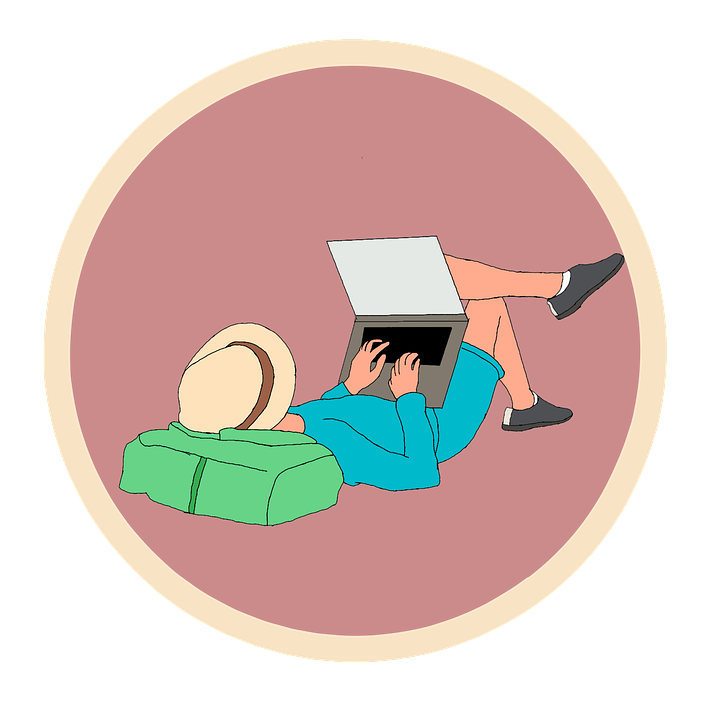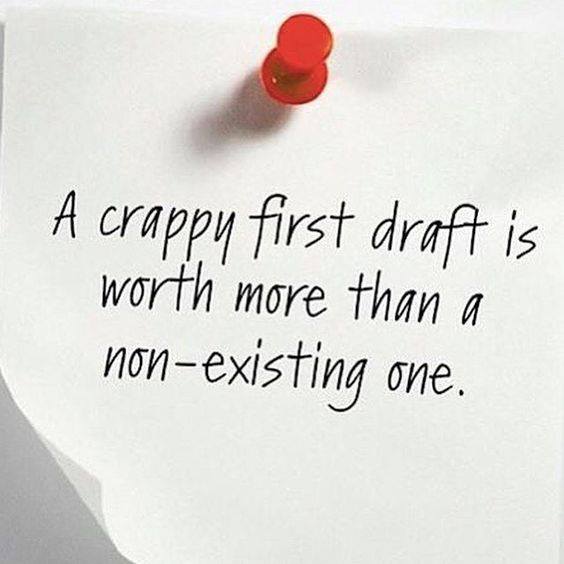
Do you feel like scientific writing is a long, draining process? Maybe you are a perfectionist who struggles with each sentence and questions every other word. Or you can write down a draft quickly, only to realize that it is no good and you have to start over again. In any case, learning the principles of effective drafting helps you write better first drafts faster, increasing your writing output and at the same time improving the quality of your texts.
Here you’ll find six principles that will make a qualitative and quantitative difference to your writing. This approach is based on the freewriting technique, and the main points are illustrated with quotes from Peter Elbow, the godfather of freewriting and a well-respected writing educator and researcher. These quotes from the book Writing with power not only offer valuable advice — they also provide a great example that even writing about a seemingly boring topic can be captivating and powerful.
1. Separate drafting and revising
If you are ever going to follow only one piece of writing advice, it should be this: don’t write and revise at the same time. Don’t switch back and forth between generating text and improving it. Because the processes of drafting and revising are polar opposites, they require your mind to operate in two distinct modes: fully attached to actively experience the thought vs. fully detached to critically evaluate the text.
Switching back and forth between drafting and revising is nothing else than multitasking. And this comprises the well-known time and energy cost of multitasking, making us produce mediocre text at a mediocre tempo.
Peter Elbow exemplifies the problems of concurrent writing and revising in the following way:
Premature revising is counterproductive in various ways. When we put ourselves in a correcting, fault-finding frame of mind, we usually have more trouble coming up with new and interesting ideas. We see faults in ideas before we’ve had a chance to work them out, and we get distracted in our thinking by all the fixing and correcting at the surface level. Besides, premature revising usually gets us to spend time fixing or correcting things that we later throw away. Or worse yet, we don’t throw away something we ought to throw away, because we’ve invested so much time and energy massaging it that we can’t bear to let it go.
So when you sit down to write a first draft, it’s best to do just that: produce words. Don’t read the text to fix it. But also don’t interrupt your writing to look up missing information. Work with placeholders instead.

- You need a reference for your claim? Write “[REF]” and move on.
- You forgot a certain value that you want to report? Write “X” and look it up later.
- You are not sure whether the word you just used is the right one / spelled correctly / etc.? Write it down and mark it for a later revision.
- You can’t decide which word to use? Write them down all (“word1/word2/etc.”) and decide later.
- You don’t remember a certain word in English, just in your mother tongue? No problem — write what you have and translate later.
Isolating the act of drafting not only makes writing faster (by avoiding the cost of multitasking), it also results in a better text because you don’t interrupt your thinking as you write.
If you are a top-down writer, you probably find it hard to separate drafting and revising. You can learn this essential skill by practicing freewriting. Moreover, the next tips below should help you as well, especially the advice to focus on content, experience your thought, and give yourself a permission to write badly in the first draft.
2. Focus fully on content
One of the reasons why we need to separate the processes of drafting and revising is that this allows us to direct our full attention to the content. We need to stop worrying about the language and the quality of our writing, and focus fully on the content in order to reach the state of flow to write productively and effortlessly.
In Peter Elbow’s words:
Put all your attention into connecting wholeheartedly with your thoughts and get inside them instead of trying so hard to find the right language for communicating them.
3. Experience your thought
 We need to focus fully on the content as we write because this allows us to experience what we write about. Experiencing your thoughts means that you are closely connected to what you think about, and this connection brings focus and clarity in your thinking that translates into writing.
We need to focus fully on the content as we write because this allows us to experience what we write about. Experiencing your thoughts means that you are closely connected to what you think about, and this connection brings focus and clarity in your thinking that translates into writing.
Peter Elbow suggests that experiencing your thoughts is exactly the quality of mind you need to achieve in order to write powerful texts:
If you want your reader to experience your thinking and not just manage to understand it—if you want him to feel your thoughts alive inside him or hear the music of your ideas—then you must experience your thoughts fully as you write.
Experiencing your thinking happens naturally when you think something for the first time. Though when something is well-known, even boring to you, you need a little trick to get yourself in the actively experiencing mode:
If you are not really experiencing your thoughts as you write, pretend you are the first person who ever had that thought and write excitedly about your new breakthrough.
But there will be times when you are tired or distracted, which makes you detached from your thoughts. Even in such cases, it may be possible to connect with your thoughts, albeit it will require a bit more effort:
Even though experiencing requires more energy than not experiencing, if things go well you naturally and easily do experience what you are writing about. To experience fully is natural, human, and alive. But when you are tired, under pressure, scared, or distracted, it takes an act of special effort and self-management to get yourself to experience fully what you are writing about. You need to learn to stop, concentrate your energy, and focus your attention wholeheartedly on your meaning—and do it so vigorously that you don’t have any energy or attention left over for worries or distractions.
4. Forget about the reader

Taking the reader’s perspective is crucial if you want to produce a useful and comprehensible text. However, it’s best to consider the reader and their needs in the planning phase before drafting, and in the revision phase after drafting.
As you write the first draft, it’s often best to completely forget about the reader, especially if you are a top-down writer and easily get the “writer’s block”. Ignoring the reader while drafting helps you keep focused on the content and connected with your thoughts, as well as avoid the pressure to write well that often leads to writer’s block.
However, if you are a bottom-up writer who doesn’t get blocked easily, you can imagine to have a conversation with the reader. This might help you focus on the essentials and avoid diverting too much, making your text more structured and easier to revise.
5. Allow yourself to write a crappy first draft
Now, the perfectionist top-down writer might struggle to separate drafting from revising and focus fully on the content. But in my experience, they only need a little trick to resolve this issue, and that is to consciously give themselves a permission to write badly in the first draft.
So don’t be afraid to write a “crappy first draft” — you can improve it later. Nobody needs to see your first draft, so there is no pressure to get it perfect right away.
As Peter Elbow says:
Coherence is not the goal of raw writing, life is. Coherence is what you must impose on raw writing as you revise.

It is much easier to iteratively improve a “crappy” sentence than to try in your mind to come up with a “perfect” one. In the moment you relax and allow yourself to not care about the quality of your writing, you will resolve your writer’s block and your writing productivity will increase enormously.
And you might be surprised when you sit down to edit your “crappy first draft” that it’s not that bad at all…
6. Plan & outline before drafting
Bottom-up writers don’t find it difficult to separate writing from revising and to write down a lively first draft quickly. Quite the opposite: their first draft might be too lively and chaotic so that it needs extensive revising. Often such a writer decides to write a completely new draft instead of fighting with what they already have.
Solution to this unfavorable situation is to resist the temptation to dive straight into the writing, and plan & outline beforehand. You don’t need to have the definite outline for your text — a working version is enough. You can finalize the structure as you revise, by rearranging the bits you have written. But it will be helpful if you brainstorm the points you want to include in your text, and try to get them in some sort of logical order before you start drafting the text.
How to revise & keep the power of the first draft
You might wonder whether it makes any sense to bother with experiencing your thoughts to write powerful sentences if you are going to revise them later anyway. Well, Peter Elbow has good advice also on this matter:
If you revise only by cutting and rearranging elements in your raw writing, you end up with a revision made only of first-draft words—words written while you were experiencing your subject matter and not thinking about writing. But you can also add new words and passages as you revise—self-consciously and critically making judgments about what the style, context, audience, and meaning demand. When your raw writing grows directly out of full experience of your subject, the life entrapped in these words enables you to generate more words during the revising process that also contain life. The life in those original words keeps you in touch with the experience and enables you to dart back into it even if only for a moment as you search for a better word or phrase—even though you are engaged in the cold, calculating process of revising.
Now you know how you can write powerful text quickly and easily. The next step is to implement the advice in your own writing. A great practice that prepares you well for this drafting strategy is freewriting. And freewriting can be really fun! So don’t wait too long and try it out. Freewriting helps you develop your scientific writing skills in a relaxed and enjoyable way.
Once you have drafted your text, you should further develop and improve it in a process of step-wise revising, starting with content and finishing with language & style. Our revision checklist helps you with detailed instructions, so get your copy here:
Thank you, your information is really helpful.